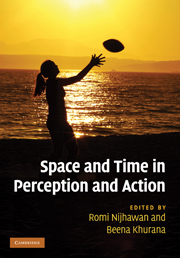Book contents
- Frontmatter
- Contents
- List of contributors
- Acknowledgments
- 1 Space and time: the fabric of thought and reality
- Part I Time–space during action: perisaccadic mislocalization and reaching
- Part II Temporal phenomena: perception
- 10 Saccadic chronostasis and the continuity of subjective temporal experience across eye movements
- 11 Experiencing the future: the influence of self-initiation on temporal perception
- 12 On the perceived interdependence of space and time: evidence for spatial priming in the temporal kappa effect
- Part III Temporal phenomena: binding and asynchrony
- Part IV Spatial phenomena: forward shift effects
- Part V Space–time and awareness
- Index
- References
11 - Experiencing the future: the influence of self-initiation on temporal perception
from Part II - Temporal phenomena: perception
Published online by Cambridge University Press: 05 October 2010
- Frontmatter
- Contents
- List of contributors
- Acknowledgments
- 1 Space and time: the fabric of thought and reality
- Part I Time–space during action: perisaccadic mislocalization and reaching
- Part II Temporal phenomena: perception
- 10 Saccadic chronostasis and the continuity of subjective temporal experience across eye movements
- 11 Experiencing the future: the influence of self-initiation on temporal perception
- 12 On the perceived interdependence of space and time: evidence for spatial priming in the temporal kappa effect
- Part III Temporal phenomena: binding and asynchrony
- Part IV Spatial phenomena: forward shift effects
- Part V Space–time and awareness
- Index
- References
Summary
Summary
Anticipation is a hallmark of skilled movements. For example, when removing plates from a loaded tray, the upward force generated by the supporting hand is reduced in anticipation of the reduced load. An adjustment of the postural force occurs as a result of the predicted consequences of the self-initiated action. Although the effect of anticipatory processes is easily discerned in the actions themselves, it is unclear whether these processes also affect our perceptual experience. In this chapter we focus on the relationship between action and the perceptual experience. We begin by reviewing how actions provide reliable predictions of forthcoming sensory information. Following this, we discuss how the anticipation of the time of external events is an important component of action-linked expectations. Finally, we report two experiments that examine how temporal predictions are integrated with the incoming sensory information, evaluating whether this integration occurs in a statistically optimal manner. This predictive process provides the important advantage of compensating for lags in conduction time between peripheral input and the central integration of this information, thus overcoming the physical limitations of sensory channels.
Racing against sensory delays
An important problem for the brain to solve is how to compensate for the temporal gap between when a stimulus is registered by a sensory detector and when it is recognized, either consciously or subconsciously, in the cortex. In humans, such delays happen on the order of hundreds of milliseconds (for review, see Welch & Warren 1986).
Information
- Type
- Chapter
- Information
- Space and Time in Perception and Action , pp. 164 - 180Publisher: Cambridge University PressPrint publication year: 2010
